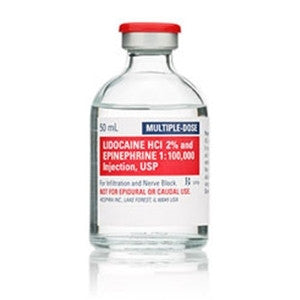Lidocaine 2% with Epinephrine 2% 1:100,000 for Injection 50 mL Multiple Dose, 25/Pack (Rx)
(Note: We don’t Fill Personal Prescriptions)
How to Order:
You will receive instructions on how to create an account along with Rx Ordering Details.
Lidocaine 2% with Epinephrine 2% 1:100,000 is an injectable local anesthetic used to provide pain relief and reduce bleeding during surgical, dental, or other medical procedures. Lidocaine, an anesthetic agent, blocks nerve signals in the body, while epinephrine, a vasoconstrictor, decreases blood flow to the area, prolonging the anesthetic effect and minimizing bleeding. This combination is commonly utilized in various clinical settings to enhance the effectiveness and duration of anesthesia.
Lidocaine 2% with Epinephrine 1:100,000 injection is a local anesthetic and vasoconstrictor combination product used to numb a specific area and reduce bleeding during surgical or dental procedures. Manufactured by Pfizer Injectables, this formulation is available in a 50 mL multiple-dose vial and often comes in 25-pack quantities for professional use.
Details and Features
Lidocaine Concentration: 2%
Epinephrine Concentration: 1:100,000
Volume: 50 mL per vial
Packaging: Multiple dose vials, 25 vials per pack
Preservative: Contains specific preservatives suitable for multiple uses as a vial.
Manufacturer: Pfizer Injectables
Usage: Indicated for numbing tissue in a specific area and minimizing bleeding through vasoconstriction.
Mechanism of Action
Lidocaine: Works by blocking sodium channels, which inhibits the propagation of nerve impulses. This blockage results in a local anesthetic effect by temporarily numbing the area.
Epinephrine: Acts as a vasoconstrictor by stimulating alpha-adrenergic receptors, leading to decreased blood flow to the targeted area. This prolongs the effect of lidocaine and reduces bleeding.
Warnings
-
Allergic Reactions: Potential for allergic reactions to lidocaine or similar anesthetics.
-
Cardiovascular Concerns: Use with caution in patients with cardiac disorders, hypertension, or peripheral vascular disease due to the vasoconstrictor action of epinephrine.
-
Patient History: Obtain complete medical history before use, especially regarding heart conditions, thyroid disorders, or allergies.
-
Overdosage: Watch for toxic reactions associated with high doses or rapid absorption of lidocaine.
- Improper Injection Techniques: Avoid intravascular injection; always aspirate before injecting.
Side Effects
Common Side Effects:
- Site reaction (redness, swelling)
- Mild numbness or tingling
Serious Side Effects:
-
Cardiovascular issues: Tachycardia, hypertension, or arrhythmias due to epinephrine.
-
CNS Effects: Dizziness, tremors, or seizures due to lidocaine.
-
Allergic Reactions: Rash, itching, swelling, or severe dizziness.
-
Local Effects: Prolonged or permanent numbness or tingling.
- Systemic Toxicity: Symptoms may include metallic taste, numbness around the mouth, tinnitus, or blurry vision, indicating rising systemic lidocaine levels.
Note: This medication should only be administered by qualified healthcare practitioners, within appropriate medical settings, and with facilities for monitoring and emergency management of potential adverse reactions. Always refer to the full prescribing information and package insert for complete details


